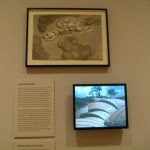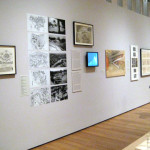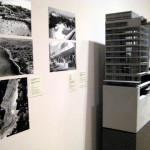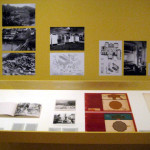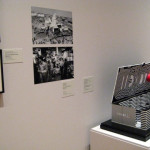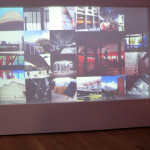
Latin America in Construction: MoMA redefines the International Style
In 1929, while lecturing in Buenos Aires, Le Corbusier deftly sketched some classical references – a broken pediment; orders Doric, Ionic, and Corinthian; an approximation of the Parthenon – and then crossed them out with a big red “X.” ‘Ceci n’est pas l’architecture,’ he scrawled below, in downward sloping cursive. ‘Ce sont les styles.’
That drawing, created in the same year as René Magritte’s famous painterly protest of a pipe, is among the first works that visitors encounter in the Museum of Modern Art’s invigorating and incisive survey of modern architecture in Latin America, and it acts as a kind of opening bell for a 25-year, 11-country (Chile, Argentina, Uruguay, Brazil, Peru, Colombia, Venezuela, Mexico, Cuba, the Dominican Republic, and Puerto Rico) bout of old versus new in which innovation, complexity and radical originality emerge on top.
Corbusier’s sketch does more than set the tone for a regional rethinking of academic tradition and the Beaux-Arts legacy of city planning, explains MoMA curator Barry Bergdoll. Bergdoll has organised the exhibition over the last seven years, with Patricio del Real, Jorge Francisco Liernur, and Carlos Eduardo Comas. ‘It points to the fact that Le Corbusier had gone to South America in 1929 – he only visited North America for the first time in 1935 – and Frank Lloyd Wright in 1931, yet no Latin American buildings were included in that seminal defining [MoMA] show, The International Style, which was anything but international!’
This ambitious survey picks up where yet another landmark MoMA show – Latin American Architecture Since 1945 – left off. ‘The 1955 exhibition was a photographic field report on contemporary architecture of the previous decade,’ says Bergdoll. ‘This is a historical inquiry into a quarter century that ended thirty-five years ago.’
Visitors are plunged into ‘a region in motion’, with the help of a seven-screen installation that plays 693 precisely coordinated excerpts of archival footage that reveal the rapidly changing rhythms of life in major cities such as Montevideo, Buenos Aires, São Paulo, and Rio de Janeiro amidst Latin America’s spectacular post-1945 urbanisation. ‘These archival films…allow a view of the work in human context of how a building is birthed, how it lives, and how it may even fade to dust,’ notes Joey Forsyte, who researched and edited the mega-anthology.
A myriad of approaches to the ideal future city come into focus through approximately 500 original works, from newly commissioned large-scale models and a portfolio by Brazilian photographer Leonardo Finotti to original drawings and ephemera. Set against a vast yellow timeline wall of key historical events, thematic sections tackle topics such as campus design and the ciudad universitaria (university city), the modernist dream fulfilled of Brasília, and the global export of Latin American urban planning models. The result is a rich network of ideas, influences, and collaborators including Alexander Calder, whose ‘acoustic clouds’ float in the auditorium of Carlos Raúl Villanueva’s Aula Magna at La Ciudad Universitaria de Caracas. Notable too is Louis Kahn, who tapped Luis Barragán for help on the decidedly non-tropical court of the Salk Institute in California.
If the density, pace and sheer range of such a show sounds like it could overwhelm, well, that’s by design. Bergdoll expects visitors to leave surprised by ‘the sheer quantity of excellent architecture, the breathtaking speed of urban transformations and the vast variety of innovations and explorations,’ along with plenty of individual discoveries. ‘A building like the Banco de Londres in Buenos Aires, or the Torres del Parque in Bogota should be as famous as Frank Lloyd Wright’s Fallingwater or Guggenheim for example,’ he adds, ‘and Lina Bo Bardi’s SESC Pompeii is a built utopia.
(From: Wallpaper)



